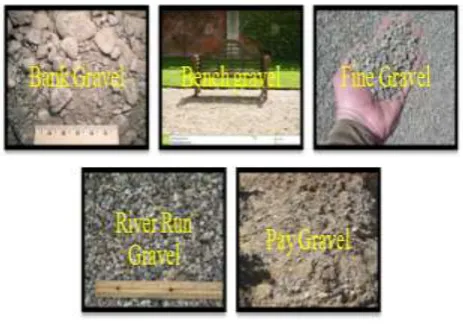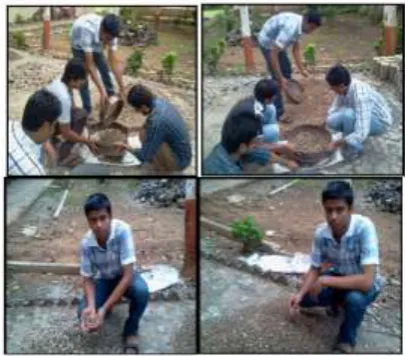ISSN: 2231-5381 http://www.ijettjournal.org
Page 4306Assessment For Use Of Gravel In Pervious Concrete
Darshan S. Shah 1, Prof. Jayeshkumar Pitroda2
1
Student of final year M.E. (C.E M), B.V.M Engineering College, Vallabh Vidyanagar
2
Assistant Professor and Research Scholar, Civil Engineering Department, B.V.M. Engineering College, Vallabh Vidyanagar-Gujarat-India
Abstract: Gravel is an important commercial product, with a number of applications. Many roadways are surfaced with gravel, especially in rural areas where there is little traffic or less wheel load. Globally, so many roads are surfaced with gravel, which are used in concrete especially in Russia, which covers 4,00,000 km of gravel roads. Gravel is formed as a result of the Weathering and Erosion of the rocks. Gravel is an alternate material in place of the aggregate which in turn used for making concrete when it is properly mixed with cement and water. Gravel is used for making a special concrete like “Pervious Concrete” and for that purpose, specially 3/4 inch (18.75 mm) and 3/8 inch (9.375 mm) gravel has been taken. For obtaining these two types of gravel from the available quantity sieve analysis has been carried out. Specific gravity, Water absorption and bulk density of gravel is also found out. Gravel becoming compacted and concreted into sedimentary rock called as a conglomerate. Mostly gravel is produced by quarrying and crushing hard-wearing rocks, such as sandstone, limestone, or basalt. Quarries where gravel is extracted are known as gravel pits.
Keywords: Gravel, weathering, erosion, pervious concrete, sieve analysis, specific gravity, water absorption, bulk density, gravel pits, sedimentary, conglomerate
INTRODUCTION
Concrete is a homogeneous mixture of cement, aggregate (fine aggregate and coarse aggregate) and water. Now a days special concrete is more preferred in the construction industry. Some of the special concretes are pervious concrete, transparent concrete, high volume fly ash concrete, self compacted and curing concrete because of their special properties which is better compared to conventional concrete. Concrete is also made when gravel is used in place of the aggregate. One of the best example to understand gravel use and its properties is to produce a Pervious Concrete. Pervious Concrete is a special type of concrete in which no fine aggregates are used and gravel has been used in place of the coarse aggregate.
Pervious Concrete is also called as “no-fines”
concrete.
Gravel is formed as a result of weathering and erosion of the rocks. It is a commercial product with a number of applications. It is produced by quarrying and crushing hard-wearing rocks, such as sandstone, limestone, or basalt. The place where the gravel is extracted is called as gravel pits.
Gravel is generally found in nature in river beds but this is not suitable for the building industry including road construction due to its rounded shape. This round shaped gravel is used as a filter material in dams, water filtration plants and sub-soil drains for amelioration of saline sub-soils.
Gravel which is used for the building as well as road industry obtained from rocks excavated from quarries. Dynamites are used for blasting of these rocks and then break this gravel to the required size with the help of the mechanical crushers. Most of the gravels are rounded and sub angular in their appearance.
TYPES OF GRAVEL
Figure 1: Types of gravel
CATEGORY OF GRAVEL
ISSN: 2231-5381 http://www.ijettjournal.org
Page 4307 Figure 2: Category of gravelPROPERTIES OF GRAVEL:
Gravel has certain properties which have to check before it should be used in concrete. Basic
properties of gravel are Sieve Analysis for the
Gradation of Gravel, Specific Gravity, Water Absorption and Bulk Density. All these properties of gravel are determined before the gravel has been used in concrete, because all these properties are directly affected on design and behavior of concrete. Properties of gravel are determined by performing all these tests according to IS code.
Figure 3: Properties of gravel
TEST OF PROPERTIES AND
METHODOLOGY:
[1] SIEVE ANALYSIS FOR THE
GRADATION OF GRAVEL [IS 2368– (PART – I) 1963]
This test consists of the simple operation of dividing gravels into different fractions, each fraction consists of same size particles. The sieves used to carry out the test have square opening. Sieves are described by the size of their openings are 80 mm, 63 mm, 50 mm, 40 mm, 25 mm, 20 mm, 16 mm, 12.5 mm, 10 mm, 4.75 mm, 2.36 mm, 1.18 mm, 600 µm, 300 µm, 150 µm. All these sieves are mounted on a sieve shaker. Gravel of known quantity is placed over the top of the sieve and after sieving through the test sieves, the residue on each sieve is weighted. The percentage of
weight retained to the total weight is calculated, from which the percentage passing is obtained.
This paper represents, gravel is mainly used in place of the coarse aggregates for the making of Pervious Concrete and for that purpose two different sizes of gravel i.e. 3/4 inch (18.75 mm) and 3/8 inch (9.375 mm) are used. 1000 kg of total quantity of gravel has been purchased and sieve analysis was carried out to separate these two different size of gravel. Out of this 1000 kg, about 500 kg of gravel is in the range of 6 to 12 mm and 300 kg of gravel is in the range of 16 to 20 mm. The remaining 200 kg of gravel is below and above the requirement.
Figure 4: Sieve Analysis of Gravel
[2] SPECIFIC GRAVITY OF GRAVEL [IS: 2386 – (PART – III) 1963]
Specific Gravity is defined as the ratio of the weight of the gravel to its solid volume that is equal to the weight of the water that is displaced by it.
Pycnometer bottle having watertight fitting, a tray and scale are the main apparatus to find out specific gravity.
ISSN: 2231-5381 http://www.ijettjournal.org
Page 4308 Figure 5: Procedure for specific gravity testFigure 6: Specific gravity of gravel
RESULT OF SPECIFIC GRAVITY TEST:
TABLE 1
SPECIFIC GRAVITY OF 9.375 mm GRAVEL
Specific gravity of 9.375 mm Gravel:
W1 = Weight of Pycnometer
Empty Bottle
= 0.535 kg
W2 = Weight of Pycnometer
Bottle + Gravel
= 0.95 kg
W3 = Weight of Pycnometer
Bottle + 10mm Gravel + Water
= 1.53 kg
W4 = Weight of Pycnometer
Bottle + Water
= 1.33 kg
Specific Gravity of 10mm gravel =
–
= – –
= 1.93
TABLE 2
SPECIFIC GRAVITY OF 18.75 mm GRAVEL
Specific gravity of 18.75 mm Gravel:
W1 = Weight of Pycnometer
Empty Bottle
= 0.535 kg
W2 = Weight of Pycnometer
Bottle + Gravel
= 0.974 kg
W3 = Weight of Pycnometer
Bottle + 20mm Gravel + Water
= 1.60 kg
W4 = Weight of Pycnometer
Bottle + Water
= 1.33 kg
Specific Gravity of 20mm gravel =
–
= –
= 2.60
Graph 1: Specific Gravity of Gravel
[3] WATER ABSORPTION OF GRAVEL [IS: 2386 – (PART – III) 1963]
A certain quantity of gravel has taken and oven dry weight of these quantities is finding out say (W1). After weighting, these quantities of gravel are immersed in water for 24 hours and after 24 hours weight of the surface dry gravel quantity is measured say (W2). The percentage Water Absorption (WA) is calculated as follows. From the experimental investigation it was found that, 9.375 mm gravel has 0.88 % and 18.75 mm gravel has 0.51 % water absorption.
% Water Absorption = [(W2 – W1) / W1] x 100 Where,
ISSN: 2231-5381 http://www.ijettjournal.org
Page 4309 Graph 2: Water Absorption of Gravel[4] BULK DENSITY OF GRAVEL [IS: 2386 – (PART – III) 1963]
This method of test covers the procedure for determining unit weight or bulk density and void of gravel.The measure shill be filled to overflowing by means of a shovel or scoop, the gravel being discharged from a height not exceeding 5 cm above the top of the measure. Care shall be taken to prevent, as far as possible, segregation of the particle sizes of which the sample is composed. The surface of the gravel shall then be levelled with a straight edge. The net weight of the gravel in the measure shall then be determined and the bulk density calculated in kilogram per liter.
TABLE 3
PROPERTIES OF 9.375 MM AND 18.75 MM
GRAVEL
ADVANTAGES OF GRAVEL:
Gravel is relatively cheap and easy to lay
Gravel is fun to walk on and makes a
satisfying crunching sound underfoot
Gravel is more environmentally friendly as it
allows for water flow and drainage
Gravel is durable, strong and maintains proper
drainage
Gravel driveways are easy to maintain
DIS ADVANTAGES OF GRAVEL:
Gravel can get stuck in shoes, tire treads and
bare feet
Improperly installed gravel is likely to spread
and move from its original place
Drainage facility must be required
Only suitable for less wheel load or at a place
where the intensity of traffic is less
CONCLUSIONS:
Based on experimental investigation of properties of gravel, following observation can be concludes:
Specific gravity for 9.375 mm gravel is 1.93
and 18.75 mm gravel is 2.60, which satisfy the limit of Specific Gravity as per IS Code.
Water Absorption for 9.375 mm gravel is
0.88 % and 18.75 mm gravel is 0.51 %, which satisfy the limit of Water Absorption as per IS Code.
Bulk Density for both types of gravel found
out to be same, which satisfy the limit of Bulk Density as per IS Code.
Gravel is preferable to use it with cement and
water in place of coarse aggregate to produce a special type of concrete.
ACKNOWLEDGMENT:
The Authors thankfully acknowledge to Dr. C. L.
Patel, Chairman, Charutar Vidya Mandal,
Er.V.M.Patel, Hon.Jt. Secretary, Charutar Vidya
Mandal, Dr.F.S.Umrigar, Principal, B.V.M.
ISSN: 2231-5381 http://www.ijettjournal.org
Page 4310 REFERENCES:[1]
Crouch, L. K., Pitt, J., and Hewitt, R. (2007). “Aggregate Effects on Pervious Portland Cement Concrete Static Modulus of Elasticity.” J. Mater. Civ. Eng. 19(7), 561-568.[2]
Ghafoori, N., and Dutta, S., “Building andNon pavement Applications of No- Fines
Concrete,” Journal of Materials in Civil
Engineering, Volume 7, Number 4, November 1995, pgs. 286-289.
[3]
Montes, F., Valavala, S., and Haselbach,L.M. “A New Test Method for Porosity Measurements of Portland Cement Pervious
Concrete,” Journal of ASTM International, Vol. 2, No 1, January 2005, pp.13.
[4]
S.O. Ajamu, A.A. Jimoh, J.R. Oluremi(2012), “Evaluation of The Structural
Performance of Pervious Concrete in Construction” International Journal of Engineering and Technology Volume 2 No. 5, May, 2012.
[5]
Richard c Meininger, “ No Fines PerviousConcrete for Paving,” Concrete Intenational Vol. 10, No. 8, August 1988, pp. 20-27.
[6]
Rushton B., “Infiltration Opportunities inParking-Lot Design Reduce Runoff and Pollution”, Storm water, 2002.
AUTHOR’S BIOGRAPHY
Darshan shah was born in 1991 in Nadiad, Gujarat. He received his Bachelor of Engineering degree in Civil Engineering from the B.V.M. Engineering College, Gujarat Technological University in 2012. At present he is Final year student of Master`s Degree in Construction Engineering and Management from Birla Vishwakarma Mahavidyalaya, Gujarat Technological University. He is interested in research work on the pervious concrete utilization for rural road development.


